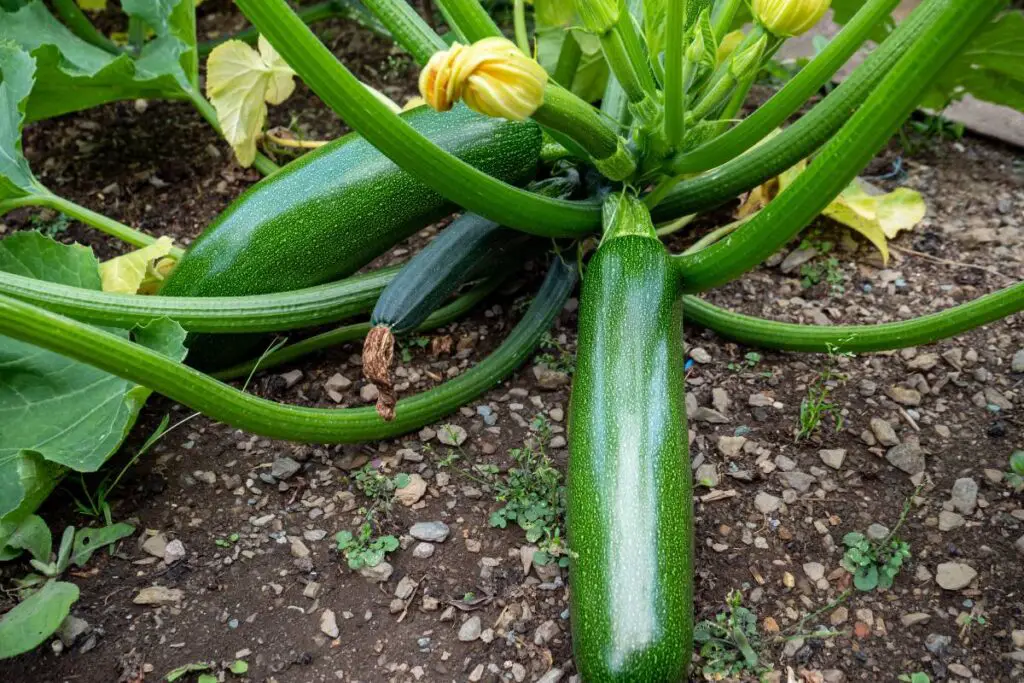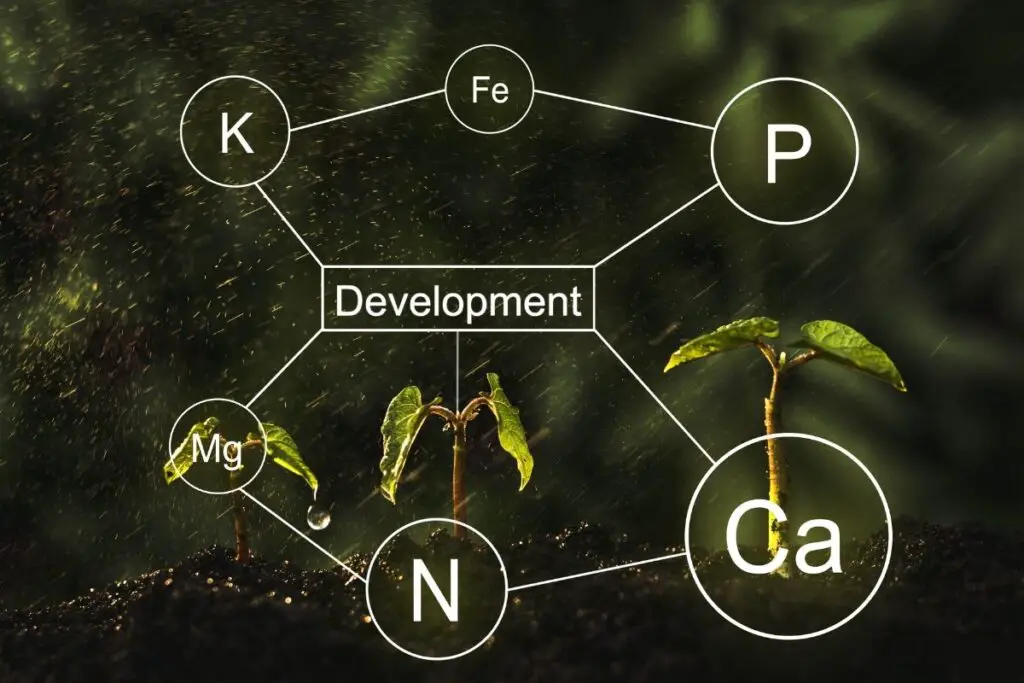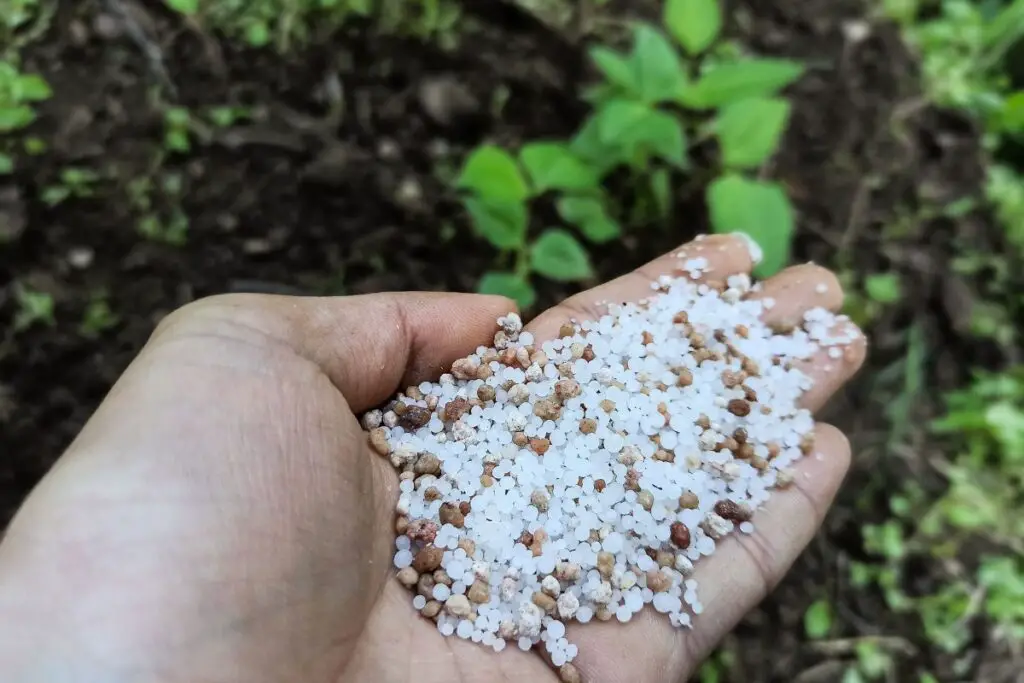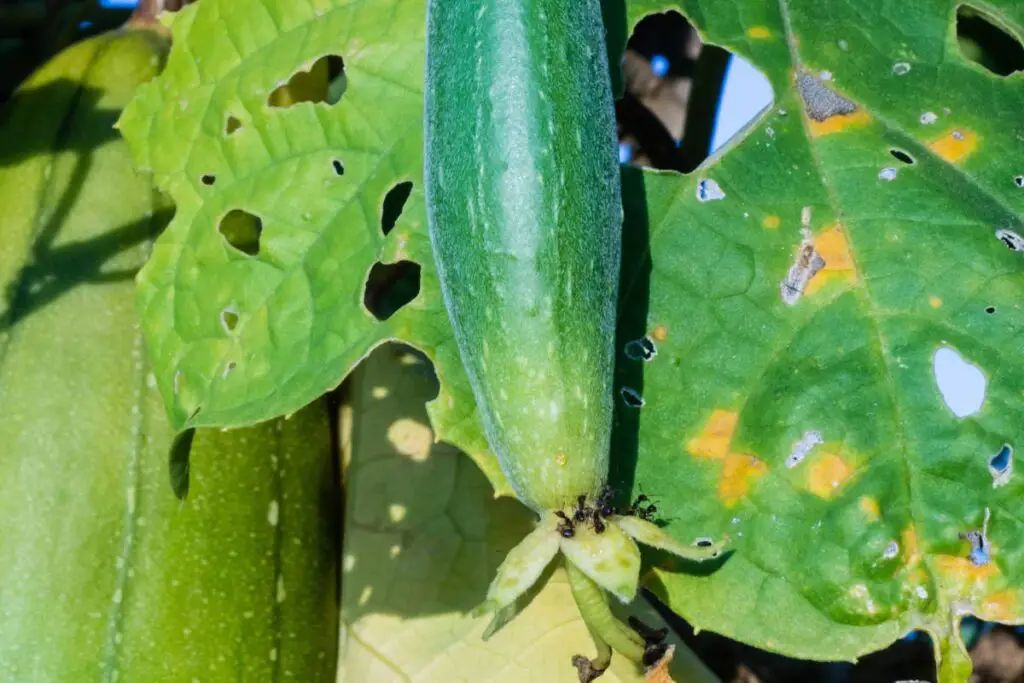Zucchini is a favorite cucurbit among gardeners. Growing them in your garden is fun, but you must know their requirements for successful growth. Today, we will share how often we should fertilize this versatile vegetable.
You don’t need to fertilize the Zucchinis right after sowing as you will already mix fertilizer during the soil preparation. Apply a balanced fertilizer with 10-10-10 NPK every 2 to 3 weeks when they start vegetative growth for 8 weeks. Re-fertilize when the plant starts blooming.
The fertilization timing and frequency depend on several things. If you are new to Zucchini fertilization, read this article till the end to learn about fertilizer importance, type, the right time to feed, frequency, and negative impacts of overfertilization.

Understanding the Importance of Fertilizing
While growing Zucchinis, I discovered that fertilization is essential.
As a plant grower, I always want all my budding plants to thrive.
Initially, I cultivated plants without fertilizers.
I relied solely on organic compost for their growth.
While organic compost is undoubtedly helpful and improves plant health, applying fertilizers separately significantly affects the plant’s overall growth and development.
After I started using fertilizers, I noticed vigorous growth in the plants.
The Zucchinis were healthy and full of big green leaves.
They produced multiple fruits, and all of them were big and healthy.
And once I noticed the difference, I never stopped feeding them.
All plants will need adequate nutrition, and Zucchinis are no different.
Now, let’s delve into how fertilization improves plant health:
- Fertilizers can provide essential nutrients to the Zucchini plants that are lacking in the soil. The three major nutrients are nitrogen, phosphorus, and potassium. Each plays a vital role in the plant’s growth and development.
- Some nutrients promote vegetative growth, and some promote fruit and flower growth. Zucchinis will need both, and when they receive the perfect amount of nutrition, the plant will be strong and produce lots of fruits and flowers.
- Fertilization will make the plant strong enough to resist stress and diseases. Your plant will suffer less from these issues, and even if it does, it will recover faster.
- Lack of nutrition causes nutrient deficiencies leading to stunted growth, yellow leaves, and reduced yields. Fertilizers can prevent this from happening and save your plant from deficiencies.
- Regular feeding maintains soil fertility. As your plants absorb the nutrients to grow, the nutrients deplete the soil’s nutrient reserves. Adding fertilizers again will replenish these nutrients to make an ideal environment for Zucchinis.
Fertilizing is essential, but remember that it is just one requirement.
Besides fertilizing, sunlight, water, soil, temperature, pest control, and disease prevention are equally important for healthy plants filled with many fruits.
Nutrient Needs of Zucchini Plants
The fertilizer you choose for Zucchini should have the nutrients important for their good growth and development.
So, what nutrients do Zucchini plants need for proper growth and development?
Zucchinis need the three major nutrients for adequate growth: nitrogen, phosphorus, and potassium.
Nitrogen helps in the vegetative growth.
Zucchinis will benefit the most when they receive nitrogen during the early growth stages.
Once the plant starts flowering, phosphorus will play a significant role in flower and fruit production.
Potassium helps in the plant’s life cycle.
It ensures strong root growth and healthy plants to resist diseases and recover from several issues faster.
When selecting a fertilizer, you must ensure these three nutrients are present.
Also, do not skip to check for minor nutrients like zinc, magnesium, calcium, iron, etc.
These micronutrients encourage strong plant cells, activate enzymes, and help the plant’s overall health.
Understanding the nutrient needs of the Zucchinis will allow you to precisely understand the plant’s needs so that you can provide them with whatever they need.
What is the Right Nutrient Ratios for Zucchini Plants?

As a beginner, it becomes difficult to understand what NPK fertilizer should be ideal for Zucchinis.
NPK stands for Nitrogen (N), Phosphorus (P), and Potassium (K).
These are the primary nutrients for Zucchinis.
When you buy a fertilizer, you must have an NPK value suitable for Zucchinis. So, what NPK fertilizer would be suitable for the Zucchinis?
Zucchinis benefit the best from an all-purpose balanced fertilizer with a 10-10-10 NPK value.
It means the fertilizer will have equal levels (10%) of the three primary fertilizers with the other micronutrients.
You can also try 5-5-5. Some gardeners have suggested that since this one goes fine, you do not have to invest money on 10-10-10.
During the early stages, Zucchinis need nitrogen. In that case, you can use 20-10-10 fertilizer.
You can use 6-18-6 or 2-5-3 at the flowering stage for more phosphorus.
Best Schedule for Fertilizing Zucchini Plants (When, How Often?)
When it comes to fertilizing, I have realized that timing is the key to proper fertilization.
You cannot fertilize the Zucchinis at any time you want.
There is a right time to fertilize the Zucchinis.
The focus should be to fertilize often enough to keep the plants healthy and happy and encourage them to produce more fruits and flowers.
At the same time, you do not want to over-fertilize or under-fertilize it.
So to determine the right frequency, you have to consider the soil type, the fertilizer type, and the size of your plant.
Soil type
If the soil is poor in nutrition, you must increase the frequency.
In that case, fertilize the Zucchinis every 2-3 weeks.
It is tempting to use excessive fertilizers in nutrient-poor soil.
But this won’t do any good; it can lead to over-fertilization.
To prevent this, use organic fertilizers.
They provide a slow and steady release of nutrients, preventing over-fertilization.
Also, organic fertilizers are less like to burn the plants.
Plant size
Fertilization begins when the plants have germinated and grown a few leaves.
If the plants are too small, do not fertilize them too much.
A bit of fertilizer would be enough to boost their growth.
You can fertilize them every 2 to 3 weeks.
Once the plant grows more leaves and reaches around 6 to 8 inches tall, increase the fertilizing frequency slowly.
Every 10-14 days would suffice.
Make sure that you water the plant before and after fertilization.
This will activate the fertilizer to release the nutrients slowly.
Also, the fertilizer’s concentration can get reduced if you have taken more amounts, preventing plant burns.
Looking for gardening supplies? We have tested 100's of products before recommending them to you guys. Check out our best pick below:
| Image | Gardening Supplies | Best Price? |
|---|---|---|
 Top
Top Top
Top | Raised Garden Bed Kit | Check On Amazon |
 | XLUX Soil Moisture Meter, Plant Water Monitor, Soil Hygrometer Sensor for Gardening, Farming, Indoor and Outdoor Plants, No Batteries Required | No Results |
 Top
Top Top
Top | 82 Pcs Garden Tools Set and Extra Succulent Tools Set | Check On Amazon |
 | Joeys Garden Expandable Garden Hose with 8 Function Hose Nozzle, Lightweight Anti-Kink Flexible Garden Hoses, Extra Strength Fabric with Double Latex Core, (50 FT, Black) | No Results |
 Top
Top Top
Top | Dual Chamber Compost Tumbler | Check On Amazon |
 Top
Top Top
Top | Sunnyglade Plant Stakes | Check On Amazon |
 Top
Top Top
Top | Organic Cold Pressed Neem Seed Oil | Check On Amazon |
 Top
Top Top
Top | Mighty Mint Gallon :-Insect and Pest Control Peppermint Oil | Check On Amazon |
 Top
Top Top
Top | Scotts DiseaseEx Lawn Fungicide | Check On Amazon |
 Top
Top Top
Top | Jacks Classic 20-20-20 All Purpose Fertilizer | Check On Amazon |
 Top
Top Top
Top | 30,000 Seeds Pollinator Attracting Wildflower Mixture | Check On Amazon |
 Top
Top Top
Top | Survival Vegetable Seeds Garden Kit-Over 16,000 Seeds | Check On Amazon |
When to fertilize?

The right time to fertilize the Zucchinis is in the early morning or late evening when the weather is cool.
At these times, the sunlight will not be very intense.
When you apply fertilizer and then water the plant, it will absorb the moisture and nutrients from the soil.
So, if the sun’s intensity is not too high, the plant can absorb enough moisture and nutrients.
But if the sun’s intensity is high, the water with the nutrients will evaporate.
In the end, only the salts of the fertilizers will stay on the soil surface.
Over time, these salts can hinder plant growth and cause stunted growth.
I fertilize my Zucchinis in the early morning when the weather is still cool, and the sun’s intensity has not increased.
Organic vs. Synthetic: Choosing the Ideal Fertilizer for Zucchini Plants
There has always been a debate between organic and synthetic fertilizers. Some prefer organic, whereas others prefer synthetic.
Organic fertilizers are derived from animal and plant matter.
These fertilizers contain both macro and micronutrients naturally.
Some organic fertilizers are manure, blood meal, bone meal, and fish emulsion.
On the other hand, synthetic fertilizers have compounds that are manufactured to replicate the macro and micronutrients.
Some compounds used in synthetic fertilizers are taken from organic fertilizers and processed to get along with synthetic fertilizers.
That is why synthetic fertilizers are easy to use.
They break down faster to release nutrients.
Both are ideal for Zucchinis. Despite being processed to replicate the macro and micronutrients, synthetic fertilizers are no less than organic.
However, excessive usage can kill your plant and contaminate water sources.
If you use synthetic fertilizers, wash the Zucchinis before eating or cooking them.
Finding the Right Amount of Fertilizer for Optimal Zucchini Growth
Using the right amount of fertilizer is very necessary.
Using the correct quantity means creating a delicate and perfectly balanced fertilizer that can highly influence the growth of the plants.
Generally, using up to 4 pounds of 10-10-10 fertilizer per 100 square feet is advised.
The exact amount depends on your garden bed size and the type of fertilizer.
For example, if you have 50 square feet of land for Zucchinis, you can use 2 pounds of granular fertilizer.
This is for the first application when you prepare the soil before planting.
In the second application, when the plant starts flowering, you can use half a cup of the same fertilizer and spread it around the plants.
It will be applied mainly in the summer.
If you use organic fertilizers, 2 tablespoons per square foot are mixed with soil around each Zucchini.
Here are a few tips about the fertilizer amounts
The amount of fertilizer can change based on the soil type, climate type, and the plant’s maturity level. Here are a few tips about how much fertilizer to use:
- Sandy soils have low fertility and require more nitrogen and phosphorus. To increase these nutrient amounts, use a fertilizer with high nitrogen content, for example, 20-10-10 NPK. Loamy soils lack potassium. Use fertilizers with higher potassium, like a 10-10-20 NPK fertilizer, to increase potassium.
- The plant age is also a factor. Mature plants need more fertilizers than those that are still starting. If you are beginning the regular fertilization, begin with a light application of a balanced fertilizer. As the plant grows, increase the amount according to the plant’s needs.
- The climate, too, plays a vital role. Warmer climates can evaporate moisture and fertilizer, and only salt remains behind. For warmer climates, focus on nitrogen, phosphorus, and potassium for cooler climates. You can use the same fertilizer type and follow the same amount described in the soil type.
I have used a lot of fertilizers for my Zucchinis. I prefer two of them the most:
- Down to Earth Organic Vegetable Garden Fertilizer 4-4-4: This is an organic slow-release fertilizer. When you use a slow release, you must reduce the frequency of application. I mix 1⅓ cups into 10 square feet of soil. I dig in and water well and then reapply it every 2 months.
- Osmocote Smart-Release Plant Food Flower & Vegetable: This is a slow-release granule slightly stronger than 10-10-10, as the NPK is 14-14-14. I water the soil very well, sprinkle the granules around the plants, and water them again to let the fertilizer release the nutrients slowly. I use it every 4 months.
Preparing the Soil
While preparing the soil for planting, it is essential to incorporate it with fertilizers before planting to encourage the soil structure and improve the nutrient levels for fast germination.
Not all the soil types in the garden will have nutrients.
Even if you add organic matter, the soil will still require nutrients that only fertilizers can provide.
So, when you prepare the soil for planting the Zucchini seeds or transplants, add some fertilizers.
When I prepare the soil for Zucchinis, I dig around 25 to 30 cm deep, remove all the old remains and weeds, and then add 8 kg of organic matter.
You do not have to use 8 kgs. You will need to choose the quantity according to your Zucchini bed. I mix them well with the soil.
After that, I add some handfuls of chicken manure pellets.
You can use any all-purpose organic fertilizer and again mix it with the soil and organic matter very well.
Then, I plant the seeds and water them well.
I prefer direct sowing because transplanting can disturb the roots and shock the plant.
Proper watering will activate the slow-release pellets and help release the nutrients slowly into the soil.
Side-Dressing Techniques
Side-dressing means applying fertilizer without disturbing the plant when it is growing actively.
It involves applying fertilizers along the plant sides, maintaining a distance of around 4 inches from the plant base.
Side-dressing provides a lot of benefits.
It boosts plant growth, both in vegetation and fruit and flower production.
Over time, the fertilizers get depleted, and the soil will lose nutrients.
Fertilizing or side-dressing provides new nutrients to the plants.
I side-dress my Zucchinis two times after the first fertilization:
- When the plant reaches a few inches tall after 2 weeks, you provide some fertilizer for 2-3 weeks. This side-dressing ensures good vegetative growth. Make sure to provide lots of nitrogen at this stage. You can use 10-10-10, 20-10-10, or 10-5-5.
- The next side-dressing is done when the plant starts flowering. In this stage, focus on applying more potassium for the fruits and flower production. At this time, use a fertilizer with NPK 6-18-6.
Organic fertilizers are applied once at the time of planting or transplanting and again when the plant starts flowering.
If you use organic fertilizers for side-dressing, apply 2 tablespoons for every square foot. Mix it with soil around every Zucchini.
You can also apply compost or manure tea monthly throughout the growing season.
Make sure it receives enough sunlight. When the fruits are ready for harvest, stop watering.
Foliar Feeding: Benefits and Application of Fertilizers to Zucchini Leaves
Foliar feeding is done to resolve any nutrient deficiency quickly.
When applied through the leaves, the plant can absorb nutrients better and faster than the soil.
Foliar feeding can strengthen the leaves, make them fuller, and even helps in resisting pests and disease.
Since the plant will directly receive the nutrients from the leaves, it will boost plant growth and faster harvest.
However, this is skipped by many gardeners because if done incorrectly or at the wrong time of the day, the leaves can get burned.
I do not prefer foliar feeding much due to this.
But I have seen some of my friends doing it.
Foliar feeding should be done in the early morning or late evening when the sun’s intensity is low.
Then, there won’t be any risks of fertilizer or sunburns.
Mix 1 oz. of liquid fertilizer per gallon of water, and spray it directly on the leaves.
Make sure to dilute the fertilizer well.
The lower the concentration, the lesser the chances of burns.
But do not overdo it.
Apply it every 1-2 weeks with a mist sprayer.
Apply the fertilizer on the top and bottom of the leaves.
Avoid foliar feeding if the temperatures are above 80°F.
Best Practices for Avoiding Overfertilization and Plant Damage

When I started noticing the positive change in Zucchini plants after fertilizing, I was more excited than when I began Zucchini gardening.
But it is important to note that fertilization has a limit and timing.
Excessive fertilization will do no good to any of the plants.
Your months of effort will go in vain, and your excitement will reduce if your plant starts suffering from over-fertilization.
So, it is imperative to fertilize the plant carefully and avoid over-fertilization.
Some signs of over-fertilization are:
- Yellowing
- Withered leaves
- Browning on the leaf margins and tips
- Leaf drops
To fix an over-fertilized plant, you need to stop fertilizing and start watering the plant thoroughly.
This will wash away the salt remains from over-fertilization.
To prevent over-fertilization, you need to follow a proper routine.
This article can help you get your ideal fertilization frequency.
Contact the nursery staff and use the fertilizers as directed for extra surety.
The best way to avoid over-fertilization is to choose organic fertilizers.
Apply them once when planting and once when flowers are seen.
Since organic fertilizers are slow-release, you don’t have to reapply them multiple times, thus saving the plant from over-fertilization.
How to apply fertilizers?
Applying fertilizers is very easy.
But as a beginner, I struggled a lot during a proper application.
In the beginning, along with organic fertilizers, I relied on liquid fertilizers as they were easy to apply.
I had to face a lot of mess.
But once I learned it well, everything was fine.
Many people are unaware of the right way to fertilize. Different fertilizers have different application methods.
Here is a small guide for those who are new to gardening:
- Granules are slow-release fertilizers. Water the plant with lots of water a few days before to moisten the soil as you will have to dig the soil. On the day of fertilizing, spread the granules around 6 inches in diameter around the soil. Please ensure they are 2 inches into the ground, then cover them with the soil. Water again to activate the fertilizer; slowly, nutrients will release into the soil.
- Liquid fertilizers are very easy to apply because they require no digging. Mix 1-2 bottle caps of fertilizer with a few gallons of water, depending on the amount you make. Pour it around the plant, and that’s all.
- Spikes are also slow-release fertilizers that come in the form of pills. Stick only 1-2 spikes next to the plant, and water the plant. This will activate the pill, and slowly, the nutrients will get released into the soil.
Ideal fertilizers for Zucchinis
I have already shared some fertilizers in this article earlier.
Besides those, I would like to share a few more, both commercial and homemade fertilizers:
Commercial fertilizers
- Burpee Natural Purpose Granular 4-Lb Organic Food for Growing Strong Plants | Good for Vegetable Garden, Flower Garden & Seed Starting, 4 lb, 4lb. Bag.
- J R Peters 52024 Jacks Classic No.1.5 20-20-20 All Purpose Fertilizer
- Miracle-Gro Shake ‘N Feed Tomato, Fruit & Vegetable Plant Food, Plant Fertilizer, 4.5 lbs.
- Dr. Earth Home Grown Tomato, Vegetable & Herb Fertilizer, 4lb.
Homemade fertilizers
In old times, there were not many commercial fertilizers.
People used to make fertilizers for their plants with all the household ingredients, for example, Epsom salt, egg shells, banana peels, etc.
My grandparents used to grow several vegetables and fertilize them with homemade fertilizers.
Even now, they do not rely much on the commercial ones.
They make their own fertilizers and use them.
That is why the vegetables and fruits of their garden are always thriving.
Organic and homemade fertilizers indeed take time to mix with the soil and show results.
But you cannot take your eyes off the gardens once the results are out.
In this section, I would like to share a few things I got to learn:
Epsom salt
Epsom salt is high in magnesium and sulfur and relieves aches and pains. It can also make a brilliant fertilizer for Zucchinis.
Add one tablespoon of Epsom salt with one gallon of water, and water the plant as usual. Use every 3 to 4 weeks.
Eggshells
Egg shells are high in calcium. They will not only increase the calcium in Zucchini plants but will also reduce slugs and snails.
Dry the eggshells, grind them into powder, and sprinkle the power over the stems and base of the plants.
Water the plant thoroughly. Use them every few weeks.
Banana peel
Bananas are high in potassium.
Soak the peels in water overnight, or grind them into power.
Make the peels crispy for grinding by drying them under the sun or baking them at a low temperature.
Once you grind them, spread the powder around the plant base. Water the plant well.
Manure tea fertilizer
Take 1 part aged manure and mix it with 5 parts water. Soak them in a container for 10 days.
Take the manure of sheep dung, chickens, or horses. Soaking will allow the manure to soften and the mixture to combine before you apply it with a sprayer.
The tea will increase the soil nutrients and protect it from pests too.
Use aged manure, not fresh manure; the latter will burn the leaves.
Final thoughts
Zucchinis are hungry plants. You must feed the plants generously to get lots of Zucchinis from your garden. A plant without fertilization may live, but you won’t receive enough fruits. Instead of only relying on organic compost, try other options to feed the plant. Several organic and synthetic fertilizers are available in the market.
Buy one of them, or make fertilizers at home with household ingredients, like banana peel, Epsom salt, egg shells, and manure. But do feed your plant. After adding fertilizer to the plant at the time of planting, reapply fertilizer when the plant reaches a few inches and when the flower starts growing.
Apply fertilizers every 2 to 4 weeks, based on the type you are using. Check your plant regularly for signs of under-fertilization and over-fertilization. If you haven’t fertilized your plants for too long, feed them. If you have overfed them, stop for a few weeks. Remember to water the plant before and after fertilization.
Will Zucchinis die if I do not fertilize?
If you take care of your plant but do not fertilize it, it will not die. But the plant will not look healthy or produce enough fruits. With fertilizers, the plant will appear attractive and healthy, and you will also have lots of fruits.
What are the signs of under-fertilization in Zucchinis?
Small and fewer numbers of fruits, slow growth, and yellow leaves with green veins are some common signs of under-fertilization. When you see these signs despite the right take and maintenance, fertilize your plants.
Reference: Zucchini Wikipedia


